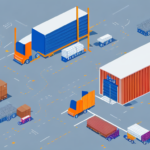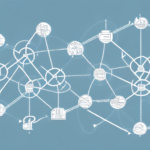An In-Depth Look at 3PLs and 4PLs: Comparing 3PLs and 4PLs
When it comes to logistics, businesses have several options to choose from. Two popular choices are third-party logistics (3PL) and fourth-party logistics (4PL). In this article, we will take an in-depth look at these two options and compare them in detail. We will explore their basics, evolution, role of technology, key differences, advantages and disadvantages, how to choose the right partner, best practices, case studies, trends and future outlook, common misconceptions, and evaluation of performance.
Understanding the Basics: What are 3PLs and 4PLs?
Before we begin, let's understand what 3PLs and 4PLs are. A 3PL is a third-party logistics provider that performs logistical services for businesses. Companies outsource their logistics functions to 3PLs to reduce the stress of managing supply chains and improve efficiency. 4PLs, on the other hand, act as an ultimate lead logistics provider. They are responsible for designing, integrating, and managing the entire supply chain ecosystem.
3PLs and 4PLs have become increasingly popular in recent years due to the rise of e-commerce and globalization. With businesses expanding their reach across borders, managing supply chains efficiently has become more challenging. 3PLs and 4PLs offer specialized expertise and technology to help businesses navigate these complexities.
Another key difference between 3PLs and 4PLs is the level of control they have over the supply chain. While 3PLs handle specific logistics functions, such as transportation or warehousing, 4PLs take a more holistic approach. They oversee the entire supply chain, from sourcing raw materials to delivering finished products to customers. This level of control allows 4PLs to optimize the supply chain for maximum efficiency and cost savings.
The Evolution of Logistics: From 1PL to 4PL
Logistics has been around for ages. The evolution of logistics started with 1PL, where businesses owned and managed their supply chains. As businesses began to expand, they outsourced some of their supply chain functions to 2PLs. This evolved into 3PLs, where logistics services were provided by specialized companies. Finally, we arrived at 4PLs, where an entire logistics ecosystem is outsourced to a single provider.
With the rise of e-commerce and globalization, the demand for efficient and effective logistics has increased. This has led to the development of new technologies such as automation, artificial intelligence, and blockchain, which are being integrated into logistics operations to improve speed, accuracy, and transparency.
Moreover, sustainability has become a key consideration in logistics. Companies are now seeking ways to reduce their carbon footprint and minimize waste in their supply chains. This has led to the adoption of green logistics practices such as using electric vehicles, optimizing transportation routes, and reducing packaging materials.
The Role of Technology in 3PLs and 4PLs
In today's world, technology plays a pivotal role in logistics. Automation and digitalization have revolutionized the logistics industry. Many 3PLs and 4PLs use Transportation Management Systems (TMS), Warehouse Management Systems (WMS), and Enterprise Resource Planning (ERP) systems. These technologies help them manage their operations efficiently and effectively.
Moreover, the use of technology has also enabled 3PLs and 4PLs to provide better visibility and transparency to their clients. Real-time tracking and monitoring of shipments, inventory levels, and order status have become possible with the help of technology. This has not only improved customer satisfaction but also helped in building trust and long-term relationships with clients.
Key Differences between 3PLs and 4PLs: Which One is Right for You?
When it comes to selecting between 3PLs and 4PLs, businesses need to consider various factors. The most significant difference between the two is that 4PLs manage the entire supply chain, whereas 3PLs manage specific functions. If you want to outsource your entire supply chain operations to a single provider, 4PLs are the best choice. 3PLs can be a good choice if you want to outsource specific functions like warehousing, transportation, or distribution.
Another key difference between 3PLs and 4PLs is the level of control businesses have over their supply chain operations. With 3PLs, businesses retain more control over their operations as they are only outsourcing specific functions. However, with 4PLs, businesses relinquish more control as the provider manages the entire supply chain. This can be beneficial for businesses that want to focus on their core competencies and leave supply chain management to experts.
Additionally, 4PLs often offer more advanced technology solutions and analytics capabilities compared to 3PLs. This is because 4PLs are responsible for managing the entire supply chain and need to have a comprehensive understanding of the operations. They can leverage technology to optimize the supply chain and provide valuable insights to businesses. However, 3PLs can still offer technology solutions for the specific functions they manage, such as Transportation Management Systems or Warehouse Management Systems.
Advantages and Disadvantages of Using a 3PL vs. a 4PL
Like any other choice, both 3PLs and 4PLs have their advantages and disadvantages. 3PLs are flexible and can be customized according to business needs. They provide specialized services that businesses may not have in-house. 4PLs, on the other hand, minimize operational risks and improve supply chain visibility. However, 3PLs may not provide end-to-end services, whereas 4PLs may be more expensive. It's up to the business to evaluate their needs and choose accordingly.
Another advantage of using a 4PL is that they act as a single point of contact for all logistics operations. This means that businesses can focus on their core competencies while the 4PL manages the entire supply chain. Additionally, 4PLs have access to advanced technology and analytics tools that can help businesses optimize their logistics operations. However, businesses need to carefully consider the cost-benefit analysis of using a 4PL, as they may be more expensive than a 3PL.
Choosing the Right Logistics Partner: Factors to Consider
Choosing the right logistics partner is crucial for businesses. Some factors to consider are:
- Experience: Look for partners with a proven track record in the industry.
- Reputation: Choose providers with positive reviews and testimonials.
- Specialization: Ensure the partner specializes in the logistics services you require.
- Location: Proximity to your operations can reduce transportation time and costs.
- Technology: Advanced technological capabilities can enhance efficiency.
- Cost-Effectiveness: Evaluate the costs relative to the services provided.
Businesses should also evaluate their partner's ability to handle emergencies, scalability, and flexibility. Choosing the right partner can help businesses achieve their logistics goals effectively and efficiently.
Another important factor to consider is their sustainability practices. Businesses are increasingly concerned about reducing their carbon footprint and want to work with partners who share their values. A logistics partner who uses eco-friendly transportation methods and implements sustainable practices in their operations can help businesses achieve their sustainability goals.
Additionally, businesses should consider the level of customer service provided by their logistics partner. A partner who is responsive, communicative, and proactive in addressing issues can help businesses avoid delays and ensure smooth operations. It is important to choose a partner who is willing to work closely with the business to understand their unique needs and provide customized solutions.
Best Practices for Working with a 3PL or a 4PL
Working with a 3PL or a 4PL requires proper communication, collaboration, and coordination. Businesses should:
- Establish clear communication channels with their partners and have a shared vision.
- Assess the performance of their partners regularly and provide feedback.
- Develop a strong partnership to achieve logistics goals seamlessly.
Another important aspect is to ensure that the partner has the necessary expertise and resources to handle your specific logistics requirements. This includes having the right technology, equipment, and personnel to manage the supply chain effectively. Businesses should also consider the partner's experience in the industry and their track record of delivering quality services.
It is also essential to establish clear roles and responsibilities for both the business and the partner. This includes defining the scope of work, timelines, and performance metrics. Regular meetings and reporting can help ensure that both parties are aligned and working towards the same goals. By setting clear expectations and monitoring progress, businesses can mitigate risks and ensure that their logistics operations run smoothly.
Case Studies: Successful Implementations of 3PLs and 4PLs in Different Industries
Several businesses have successfully implemented 3PLs and 4PLs in their supply chain management. For instance, Walmart partnered with Schneider Logistics, a 3PL, to manage their transportation and distribution network. UPS Supply Chain Solutions, a 4PL, helped Ford optimize their supply chain operations. These case studies demonstrate how outsourcing logistics functions can help businesses improve efficiency and reduce costs.
In addition to Walmart and Ford, other companies have also seen success with implementing 3PLs and 4PLs. For example, Nike partnered with DHL Supply Chain to manage their global logistics operations, resulting in improved visibility and reduced lead times. Coca-Cola also worked with a 3PL, XPO Logistics, to optimize their distribution network and reduce transportation costs. These case studies highlight the versatility of outsourcing logistics functions and the potential benefits it can bring to businesses in various industries.
Trends and Future Outlook for the Logistics Industry: Impact on 3PLs and 4PLs
The logistics industry is constantly evolving. The emergence of e-commerce, globalization, sustainability, and innovation has brought new trends and challenges. 3PLs and 4PLs need to adapt to these changes and develop innovative solutions. For instance, the use of blockchain technology in logistics can enhance transparency and security. The future looks promising for 3PLs and 4PLs, provided they adopt technology and innovation.
One of the major trends in the logistics industry is the increasing demand for sustainability. Customers are becoming more conscious of the environmental impact of logistics operations and are demanding eco-friendly solutions. This has led to the adoption of green logistics practices, such as the use of electric vehicles and renewable energy sources. 3PLs and 4PLs need to incorporate sustainability into their operations to remain competitive in the market.
Another trend shaping the logistics industry is the rise of automation. With advancements in technology, logistics companies are increasingly using automation to streamline operations and reduce costs. This includes the use of drones, autonomous vehicles, and robotics. However, the adoption of automation also raises concerns about job displacement. 3PLs and 4PLs need to strike a balance between automation and human labor to ensure sustainable growth.
Common Misconceptions about the Differences between 3PLs and 4PLs
There are several misconceptions about the differences between 3PLs and 4PLs. One common misconception is that 4PLs are more expensive than 3PLs, which is not always true. Another misconception is that 3PLs cannot handle end-to-end logistics, which is also not always the case. It's essential to understand the specific needs of your business and choose the right partner accordingly.
How to Evaluate the Performance of Your Logistics Provider
Businesses should evaluate their logistics providers regularly to ensure they are meeting their goals. Some performance metrics to consider are:
- On-Time Delivery: Percentage of shipments delivered on time.
- Order Accuracy: Accuracy of orders fulfilled without errors.
- Inventory Accuracy: Precision in inventory tracking and management.
- Response Times: Speed of response to inquiries and issues.
- Customer Satisfaction: Feedback from customers regarding logistics performance.
It's also essential to assess their technology, adaptability, and flexibility. Evaluating your logistics provider's performance can help you identify areas for improvement and optimize your logistics operations.
Conclusion
Choosing between 3PLs and 4PLs can be challenging for businesses. Both have their advantages and disadvantages, and businesses need to evaluate their specific needs and goals. Working with a logistics partner requires communication, collaboration, and coordination. Establishing a strong partnership can help businesses improve efficiency, reduce costs, and achieve their logistics goals. As the logistics industry evolves, 3PLs and 4PLs need to adopt technology, innovation, and best practices to stay competitive.




















